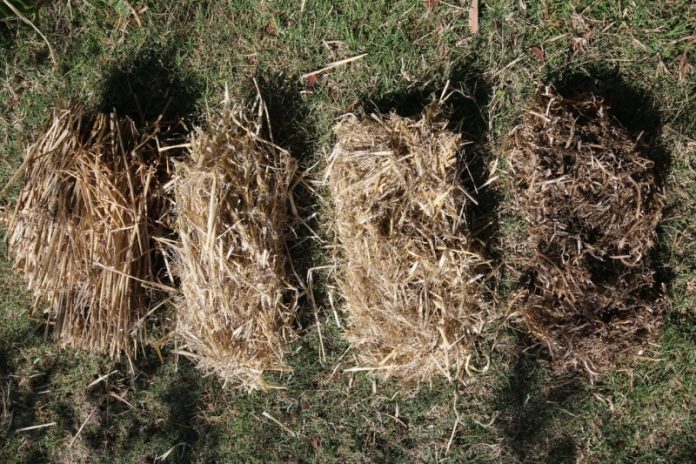It is a nice idea that we might be able to look up the details of a particular compost ingredient and find out exactly what its carbon to nitrogen ratio might be, or what its density is. But nature is varied and complex. Each batch of every ingredient we use will be different depending on the particularities of where it was grown, what variety it is and what the growing season was like that year.
‘Straw’, as a broad category, is a great example of this variation.
We have looked at straw before, how it’s the leftover stems of grain crops, totally different to hay, which is dried pasture grass, stored as animal feed.
But when we take a closer look (and looking closer is exactly what we encourage at YIMBY) we see that there is an amazing diversity in what we lump together as ‘straw’ and how each will behave in our compost pile.
Some straw is quite coarse, with each stem thick and distinct. In a compost pile coarse straw will add lots of aeration and texture in the pile, being great for a heavy, wet pile, but potentially causing problems in a compost that is already light and dry.
Coarse straw left in clumps can create breaks or gaps in our compost pile that interferes with the connection between the other ingredients and create ‘dead zones’ in the compost, so care needs to be taken to break up clumps and keep layers thin.
Some strands of coarse straw might still be present in our finished compost, being tough enough to not be fully integrated into the ‘humic’ structure of the compost.
At the other end of the texture spectrum, we find straw that is very soft and fluffy. In a compost, softer straw will collapse down easily adding its carbon to the pile quickly, but contributing less texture or aeration.
We still have to avoid big clumps of soft straw, or overly thick layers, but importantly we will need to add other ingredients (like coarse chopped up garden prunings, or even coarse straw) to add the missing texture the softer straw lacks.
Our preferred straw at YIMBY (a locally-grown barley straw) sits texturally somewhere in the middle, striking a nice balance between having enough texture to give aeration to the pile, but also being soft enough to be (mostly) integrated into a finished compost’s ‘humic’ structure.
Pea straw is a popular garden mulch, considered high in nitrogen, but it is not as good as a carbon-rich ingredient, and its soft texture adds little aeration to our piles. I don’t recommend pea straw for compost making, keep it for mulch.
Each of these ingredients are ‘straw’, but they are all quite different to each other, and each needs to be assessed for their particular role in our compost pile.
For more detail about related subjects, look up our articles ‘Hay v. Straw’, ‘Density – too heavy’ and ‘Density – too light’.
– Joel Meadows works with *Yes In My Back Yard, (YIMBY), a community-scale composting initiative in Castlemaine and surrounds. Send questions or comments to hello@yimbycompost.com, or to book in for a compost workshop.








